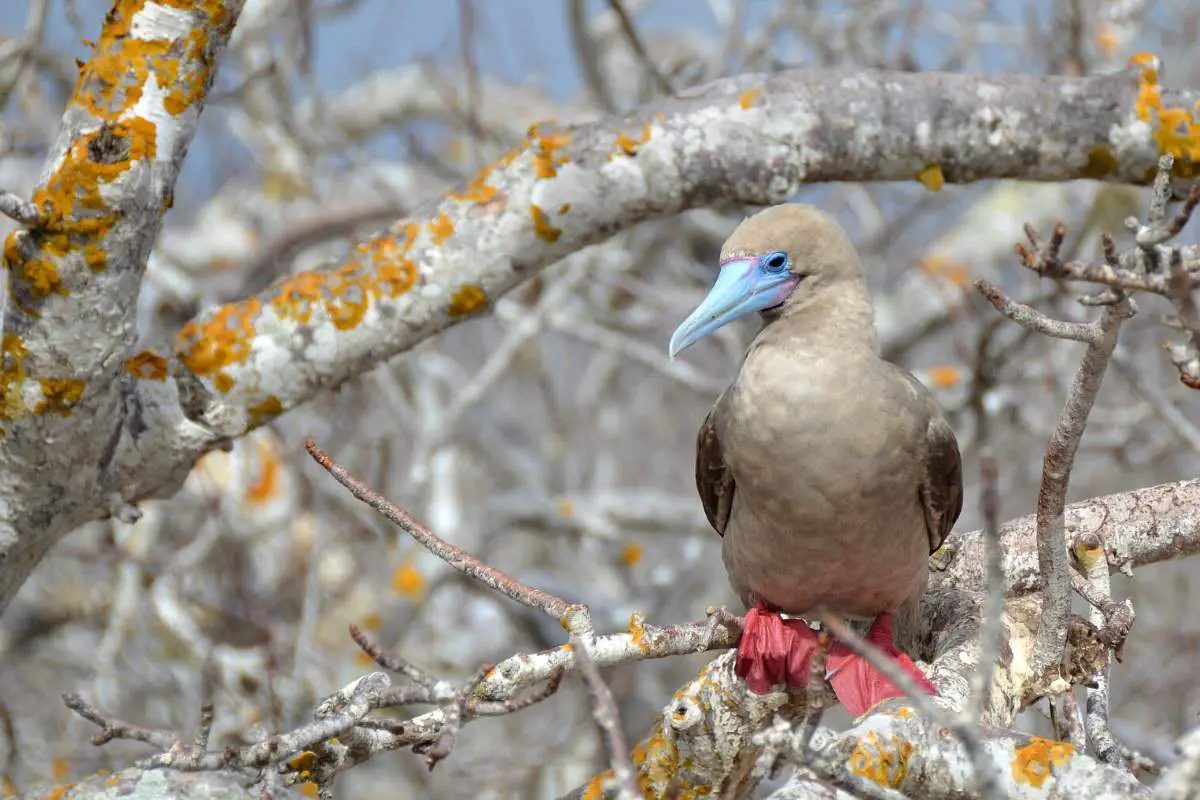Common Name: Red-footed Booby
Scientific Name: Sula sula| Size | Diet | Range in Hawaii | Status in Hawaii |
|---|---|---|---|
| 50 in. | small fish, squid, and other marine animals | All Islands | Least Concern |
The red-footed booby (Sula sula) is a seabird that is native to tropical and subtropical regions of the Atlantic, Caribbean, and Pacific Oceans. In Hawaii, it is found throughout the main islands and on a number of smaller islands. It is a member of the booby family, which includes six species of boobies, all of which are known for their striking appearance and distinctive behavior.
Red-footed Booby
Appearance

Red-footed boobies are medium-sized birds, and they can range in size depending on the specific subspecies. On average, adult red-footed boobies are about 28-33 inches (71-84 cm) in length and weigh between 1.3-2.6 lbs (0.6-1.2 kg) with long, pointed wings and a distinctive appearance.
The wingspan of a red-footed booby can be up to 50 inches (127 cm). They have a white head and neck, a white breast, and a dark brown or black back and wings. The most distinctive feature of the red-footed booby is its bright red feet, which give it its name.
The male and female red-footed booby are similar in appearance, although the male is slightly larger and has a longer bill. Juvenile red-footed boobies are similar in appearance to adults, but they have a brown or mottled brown and white plumage.
Diet
The diet of the red-footed booby consists primarily of small fish, squid, and other marine animals. They are also known to occasionally feed on insects, fruit, and nectar.
Behavior
Red-footed boobies are known for their elaborate courtship displays, in which the male performs a series of intricate maneuvers in an attempt to attract a mate. These displays may include vocalizations, body posturing, and the presentation of food to the female. Red-footed boobies are also known for their acrobatic flight skills, which they use to catch fish and other small marine animals in mid-air.
During the breeding season, these birds will return to their nesting colonies to mate and raise their young. Both male and female red-footed boobies participate in nest building and chick rearing, and they are known for their strong pair bonds.
Red-footed boobies are highly social birds, and they are often seen in large flocks at their nesting colonies. They are also known to engage in cooperative behaviors, such as working together to defend their territory or hunting for food. Outside of the breeding season, red-footed boobies are more dispersed, and they may be found alone or in small groups.
Nesting
Red-footed boobies are colonial nesters, meaning that they nest in large groups, often on cliffs or in trees. During the breeding season, these birds will return to their nesting colonies to mate and raise their young. Both male and female red-footed boobies participate in nest building, and they are known for their strong pair bonds.
Their nests are typically simple structures, consisting of a shallow depression in the ground or a small platform of sticks or twigs. The female red-footed booby lays a single egg, which is incubated by both parents for about 45 days.
Once the chick hatches, both parents take turns feeding it a regurgitated mixture of fish and other marine animals. The chick remains in the nest for about four weeks before it is able to fledge, or leave the nest.
Habitat

Red-footed boobies are adapted to a wide range of marine habitats, including coral reefs, shallow lagoons, and deep open ocean environments. They are also found in a variety of terrestrial habitats, including dry scrublands, tropical forests, and mangrove swamps.
Range
According to eBird, red-footed boobies have been observed on all of the main islands of Hawaii, including Kauai, Oahu, Molokai, Lanai, Maui, and the Big Island. They have also been observed on a number of smaller islands, including Kure Atoll, Midway Atoll, and Laysan Island.
Conservation Status
Red-footed boobies is considered to be of least concern by the International Union for Conservation of Nature (IUCN), meaning that it is not currently at risk of extinction.
Interesting Facts
1. Red-footed boobies are not aggressive
In general, red-footed boobies are not aggressive towards humans and are not typically considered to be “friendly” in the way that some domesticated pets are. However, they are also not typically fearful of humans and may approach people out of curiosity.
2. Three subspecies of Red-footed boobies
There are three subspecies of red-footed booby, they are the Caribbean red-footed booby, Galápagos red-footed booby and Pacific red-footed booby.
3. They have the potential to carry diseases
Like all wild animals, red-footed boobies have the potential to carry diseases that could be transmitted to humans. However, the risk of contracting a disease from a red-footed booby is generally considered to be low.
4. They are wild animals
Red-footed boobies are not typically kept as pets. They are wild animals that are adapted to living in a specific habitat and are not well-suited to living in a domestic setting.
Frequently Asked Questions:
How did the red-footed booby get its name?
The red-footed booby gets its name from the bright red coloring on its feet. The term “booby” is thought to come from the Spanish term “bobo,” which means “stupid” or “foolish.” This name may have been given to the bird because of its seemingly clumsy and awkward behavior on land.
How long do red footed Boobies live?
Red-footed boobies can live for a relatively long time in the wild, with some individuals living up to 25 years. However, the average lifespan of a red-footed booby is probably closer to 15-20 years. Factors that can influence a red-footed booby’s lifespan include predation, disease, and the availability of food.
Why does a red-footed booby have red feet?
The exact reason why red-footed boobies have red feet is not fully understood. It is thought that the bright red coloring of the feet may serve as a signal to other members of the species during courtship and breeding.
The red feet may also be used to communicate dominance or aggression in social interactions with other boobies. In addition, the red color of the feet may help to regulate the bird’s body temperature by dissipating heat.




